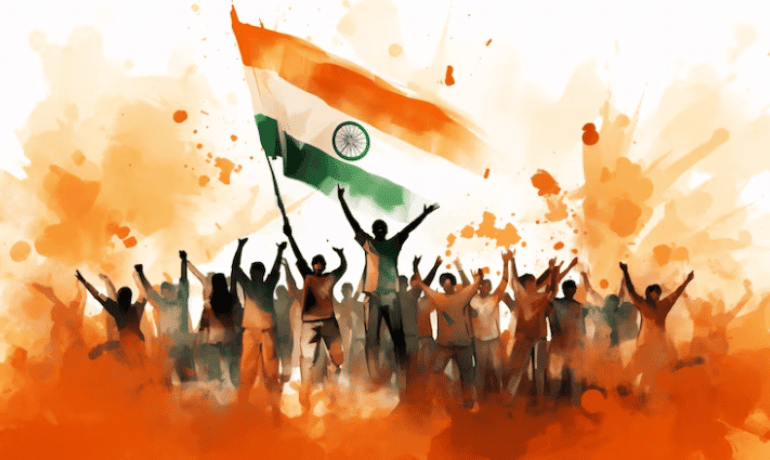The formation of the Indian National Congress (INC) in 1885 marks a pivotal moment in India’s political history. As the foundation stone of the Indian independence movement, the INC played a critical role in shaping the nation’s path toward freedom from British colonial rule. Founded by a group of educated Indians, the Congress provided a platform for voicing grievances and eventually evolved into a powerful force that galvanized millions in the fight for independence. This article takes a closer look at the origins, motivations, and impact of the Indian National Congress, exploring how it became the voice of the people during a time of political uncertainty.
The Historical Context: Why Was the Indian National Congress Formed?
Before we can understand why the Indian National Congress was formed, it’s essential to look at the political and social landscape of India in the late 19th century. By the 1880s, India had been under British rule for more than a century. The British East India Company, which initially came as a trading entity, had expanded its control, eventually establishing dominance over vast regions of the Indian subcontinent.
During this period, a significant portion of India’s population, particularly the educated elite, began to grow disillusioned with British rule. Economic policies that favored British interests over Indian welfare, coupled with discriminatory practices, created growing unrest.
Educated Indians, many of whom were exposed to Western political ideas such as democracy, self-governance, and civil rights, felt that the Indian population was being denied their basic rights and that the administration was largely indifferent to their needs. The formation of the Indian National Congress came as a response to these frustrations, aimed at uniting educated Indians and presenting a collective voice to the British government.
Who Founded the Indian National Congress?
The Indian National Congress was founded by Allan Octavian Hume, a retired British civil servant, in collaboration with prominent Indian leaders of the time such as Dadabhai Naoroji, Dinshaw Wacha, and Womesh Chunder Bonnerjee. The first meeting of the Congress took place in Bombay (now Mumbai) in December 1885, attended by 72 delegates representing various regions of India.
It is essential to note that while Allan Hume is often credited with being the driving force behind the Congress’ formation, the Indian leadership played an equally important role. They saw the INC as a forum where the educated elite could come together and advocate for political reforms, including greater representation for Indians in the governance process.
The Objectives of the Indian National Congress
In its early years, the Congress did not demand complete independence from British rule. Instead, its goals were more moderate, focusing on reforms within the colonial framework. The key objectives during the early phase of the Congress were:
- Political Representation: The Congress sought increased representation of Indians in legislative bodies.
- Civil Rights: Members aimed to protect the civil liberties of Indian citizens, pushing for equal treatment under British law.
- Economic Reforms: The INC demanded a reduction in the heavy taxes imposed on Indian peasants and advocated for policies that would promote economic development in India.
- Educational Advancement: Education was seen as a vital tool for India’s progress. The Congress wanted to expand educational opportunities for Indians, particularly in the fields of science and technology.
Early Leadership and Their Approach
The initial phase of the Indian National Congress was marked by moderate leadership, often referred to as the “Moderates”. Leaders such as Dadabhai Naoroji, Gopal Krishna Gokhale, and Pherozeshah Mehta believed that India could achieve its goals through gradual reforms and peaceful dialogue with the British authorities.
They utilized petitions, speeches, and resolutions as their main tools of protest. This phase is often characterized by a focus on constitutional methods, as the leaders believed that Britain’s democratic traditions would eventually lead to justice for India. However, this approach was not universally accepted, and over time, it became clear that more radical measures would be required to challenge British dominance.
The Shift Towards Radicalism: Rise of the Extremists
By the early 20th century, there was growing dissatisfaction among younger Congress members regarding the slow progress made under moderate leadership. A new faction, often referred to as the “Extremists”, began to gain prominence. Leaders like Bal Gangadhar Tilak, Bipin Chandra Pal, and Lala Lajpat Rai believed that passive methods were no longer effective and that more assertive action was needed to achieve the Congress’s goals.
The Extremists advocated for Swaraj, or self-rule, and were willing to employ boycotts, protests, and civil disobedience to achieve their aims. This ideological divide between the Moderates and Extremists created internal tensions within the Congress, but it also marked the beginning of a more assertive, nationalist movement that would eventually lead to India’s independence.
The Role of Congress in the Freedom Struggle
As the Indian National Congress evolved, it became the primary organization spearheading the Indian independence movement. The party’s most defining moment came with the emergence of Mahatma Gandhi as its leader in the 1920s. Gandhi introduced a new strategy of non-violent resistance, or Satyagraha, which called for mass civil disobedience against British laws while maintaining a strict commitment to non-violence.
Under Gandhi’s leadership, the Congress launched several nationwide campaigns, including the Non-Cooperation Movement (1920-1922), the Civil Disobedience Movement (1930-1934), and the Quit India Movement (1942). Each of these campaigns brought millions of ordinary Indians into the struggle for freedom, uniting people across the country in the common goal of independence.
Key Achievements and Legacy of the Indian National Congress
By the time India gained independence in 1947, the Indian National Congress had become synonymous with the freedom movement. Some of its key achievements include:
- Mobilization of Masses: The Congress succeeded in transforming the independence struggle from an elite-driven movement to a mass-based movement that included people from all walks of life.
- Promoting Unity in Diversity: Despite the many cultural, religious, and linguistic differences in India, the Congress managed to create a sense of national unity.
- Advancing Democratic Ideals: The Congress laid the foundation for India’s democratic future, advocating for self-governance and constitutional rule long before these ideas became mainstream.
- Independence from British Rule: The Congress played the most crucial role in securing India’s independence from British colonialism in 1947.
Conclusion
The formation of the Indian National Congress in 1885 was a defining moment in India’s political history. Over the years, it evolved from a moderate reformist organization to a powerful movement that demanded full independence. The journey of the Congress reflects the broader journey of India’s struggle for freedom—one that was long, arduous, and marked by both setbacks and triumphs. Today, the Indian National Congress’s legacy continues as a reminder of the sacrifices and efforts made to achieve a free and democratic India.
This comprehensive account of the formation and evolution of the INC gives a clear picture of its significance in the broader context of India’s political awakening.






